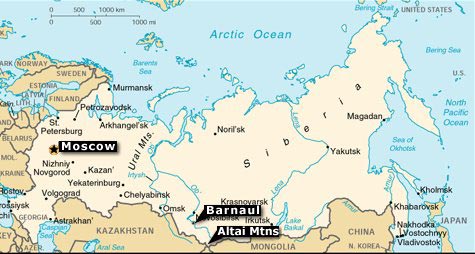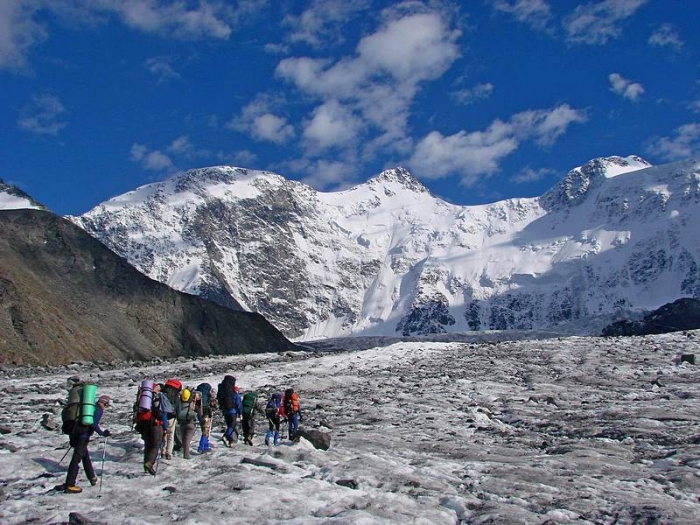Altai
Altai means "Golden Mountain". The name is in Turkic as Alytau or Altai. The starting "Al" means gold and the ending "tau" or "tai" means mount. and the given name reflects appropriately to describe an area that contains invaluable nature and a great cultural value.
Also Golden Mountains of Altai is the name of an UNESCO World Heritage Site consisting of the Altai and Katun Natural Reserves, Lake Teletskoye, Belukha Mountain, and the Ukok Plateau.

Altai is a vast mountainous area, located in the center of Eurasia at the juncture of China, Kazakhstan, Mongolia and Russia. Russian part of Altai includes the Altai Region (Barnaul is the central city) and the Republic of Altai (Gorno-Altaisk is the capital). The most attractive sites for ecotourism are concentrated in the Republic of Altai which is also called Gorny Altai. Unique natural and cultural features of Gorny Altai grant wonderful opportunities for all kinds of ecotourism activities. Also Altay mountains is a great place for other types of active tourism.

Altay mountains are the highest mountainous province of Siberia. Some mountain-masses are 3000 – 4000 m high. Their peaks are covered with snow and ice all year long. Glaciers descend along their slopes. The highest point of Siberia – Belukha Mt (4506 m) is situated there.
Altai is also famous with its rivers and lakes. Biya and Katun are the two largest rivers which interflow near the town of Biysk and give start to the Ob River – one of the greatest rivers of the world. Katun with its tributaries Chuya, Koksa, Kucherla, Argut, Ursul are very popular among whitewater rafters because of thrilling rapids and exciting landscapes. The Biya River has its source in the Teletskoye Lake which is situated between high ranges of mountains. The Teletskoye Lake ("Altin-kel" what's mean Golden Lake) with its length of about 80 km, depth of 325 m and volume of 40 cubic kilometers is considered as a symbol of Altai. The beautiful Shavlinskiye Lakes are situated on the Northern slope of the Severo-Chuysky Range.
Tavan-Bogda-Ula, or Five Sacred Summits, is a chain of giant ice domes at the border of Mongolia and Russia. in Ukok plateau. Their holy nature is related to the Buddhist myth of the Hidden Kingdom of Shambhala, which rests high in the mountains, and which can only be seen by those pure of heart. Specifically in Mongolia, an epithet "Northern" frequently accompanies the word "Shambhala" in the hymns, to reinforce the idea that it is not somewhere in Tibet, but in fact in the Sacred Summits of Altay.
The greater part of Gorny Altai is covered with taiga. Larch and cedar prevail but you can see many other species of trees and bushes. Alpine areas, situated on heights more than 2000 – 2400 m, offer large meadows with various grasses and flowers. In the whole, in Gorny Altai tourists have opportunities to observe practically all kinds of Siberian scenery: dry steppes of Central Asia, taiga, alpine meadows in blossom, tundra, majestic glaciers and snow peaks.
Fauna is very diverse too, including 90 species of mammals, 260 species of birds, 20 species of fishes. Snow leopard (irbis), wild ram, elk, Siberian stag (maral), bear, golden eagle, hawk, umber, sterlet can be met there. The climate of Altai is continental with a stable cover of snow in winter and with summer temperatures up to +300C.
Climate
Altay has pronounced continental climate with dramatic temperature variations and arid rain shadow areas.
While the higher elevations on the West flank of the mountains, and local lake effect areas near Teletskoye Lake, recieve as much as 2000 mm of precipitation a year, the Eastern Valleys typically recieve no more than 200 mm a year, and rain-shadow intermountain depressions of Chuya Steppe and Ubsu-Nur Lake as little as 100 mm.
Most of precipitation falls in spring and fall, with mid-winter dominated by an exceedingly stable Siberian High pressure area, which keeps the snowclouds away. As the result, the intermountain valleys loose snowcover to evaporation as early as in January-February. The temperatures remain extremely low however, with January averages in Chuya Steppe and Ubsu-Nur Depression at about -30 degrees C, and with cold spells up to -50 not too uncommon. So rivers and waterfalls remain frozen even in the absence of snow, and naled ice (aufeiss) is relatively common too.
The summer temperatures in the foothills are temperate, averaging approximately 20 degrees C.
The region is characterized by a continental climate with long, cold winters and short, cool summers. Snow starts covering the mountains during October and November, marking the beginning of winter. Temperatures hit the lowest in January, where they can range from 7 degrees F (-14 degrees C) in the foothills to -76 degrees F (-60 degrees C) in the steppes. In northern Siberia, one can find vast areas of permanently frozen soil. Summers begin somewhere between May and July and end in September. During this time temperatures often reach 75 degrees F (24 degrees C) during the day. Temperatures of 104 degrees F (40 degrees C) have also been recorded in the lower regions. At night, temperatures get cooler, usually ranging from 41 degrees F (5 degrees C) to 50 degrees F (10 degrees C). Elevations of 5,000 to 65,000 ft (1,500 to 19,000 m) experience high precipitation, usually ranging from 20 in (50 cm) to 40 in (1 m) a year.
The Golden Mountains of Altai are included into the UNESCO World Heritage List.
You can find more information about this protected area at
http://www.wcmc.org.uk/protected_areas/data/wh/altai.htm and
http://eng.altai-republic.ru/modules.php?op=modload&name=Sections&file=index&req=viewarticle&artid=47&page=1.
Caucasus
Caucasus tours Bezengi valley Elbrus region Arhyz DombaiKola Peninsula
Kola Peninsula toursKamchatka
Kamchatka tours Kamchatka geographical review Kamchatka trekkingKarelia
Karelia toursAltay
Altay tours Ukok plateau Mt.Belukha Chuiskiy ridge The valley of Chulyshman river and Teletskoe LakeGeorgia
Georgia toursKyrgyzstan
Kyrgyzstan tours Suusamyr Valley Terskey Ala-TooSaint-Petersburg
Saint-Petersburg tours Hotels Transfers MuseumsPolar Ural
Nomad Adventure Trans-Ural ExpressMarshrut LLC,
Fonarny str., 12, 2N.
190068, St. Petersburg, Russia
tel/fax 007 931-354-17-77
mail@newroute.ru


